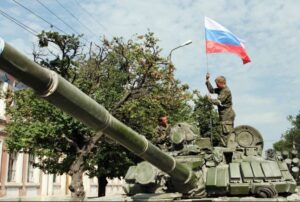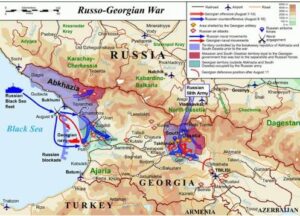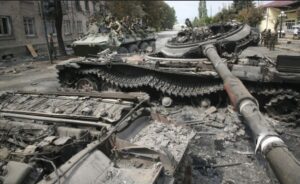 Georgia is a small nation that borders Russia, and in fact, was part of Russia at one time. The two nations had been at odds for a long time, and tempers just seemed to be simmering, with a deep heat that threatened to boil over into an all-out war. On August 8, 2008, the conflict finally hit the boiling point. What followed was a shooting war that while brief, was the most violent episode in a conflict that began more than a decade before.
Georgia is a small nation that borders Russia, and in fact, was part of Russia at one time. The two nations had been at odds for a long time, and tempers just seemed to be simmering, with a deep heat that threatened to boil over into an all-out war. On August 8, 2008, the conflict finally hit the boiling point. What followed was a shooting war that while brief, was the most violent episode in a conflict that began more than a decade before.
As the Union of Soviet Socialist Republics was breaking up in 1991, the nation of Georgia decided that it was time to declare their independence. A group of pro-Russian separatists decided that they were going to take control of two regions a short time later. The regions were composed of a combined 20 percent of Georgia’s territory, Abkhazia and South Ossetia. That, being unacceptable to Georgia, created a stalemate. In addition, in 2008, President George W Bush announced his support for Georgia’s and Ukraine’s membership in the North Atlantic Treaty Organization, something that should never have happened, and a move that Russia viewed as tantamount to putting a hostile military on its borders. I would have to agree with that assessment, and I think we are seeing the continued effects of that move to this day. I’m not saying that the people of Georgia and Ukraine are bad people, but the governments are questionable, causing Russia to take the steps it has taken.

With relations between the two nations already tense in 2008, and the aggressive nature of Vladimir Putin, who is in power in Russia, Georgian President Mikheil Saakashvili, declared his intent to bring Abkhazia and South Ossetia back under Georgian control. This didn’t go over very well. Putin and Saakashvili accused each other of acts of aggression throughout the spring and summer of 2008. On August 1st, South Ossetian troops violated the ceasefire by shelling Georgian villages. Sporadic fighting and shelling ensued over the coming days, until Saakashvili declared a ceasefire on August 7th. The separatists refused to honor the cease fire, so Georgia’s military launched an attack on Tskhinvali in South Ossetia. Russian troops had already illegally entered South Ossetia, and so they responded quickly to the Georgian attack. The fighting spilled over into Abkhazia when Georgian troops seized Tskhinvali. The initial Georgian advance was pushed back and within a few days Russia seized most of the disputed territory and was advancing into Georgia proper. The two sides agreed to a ceasefire in the early hours of August 13th. While the war was short lived, it was fierce. During the five-day conflict, 170 servicemen, 14 policemen, and 228 civilians from Georgia were killed and 1,747 wounded. In addition, 67 Russian servicemen were killed and 283 were wounded, and 365 South Ossetian servicemen and civilians (combined) were killed.

After the war, Russia formally recognized Abkhazia and South Ossetia as independent states, but stayed in occupation of them, in violation of the ceasefire. They took similar action concerning Ukraine in 2014, when they annexed the Crimean Peninsula, backing separatists in the west of the country. The Russo-Georgian War displaced an estimated 192,000 people, many of whom fled ethnic cleansing of Georgians in the separatist territories. The situation remained tense, and then once again came to a boiling point in 2022, as we have all seen.


Leave a Reply